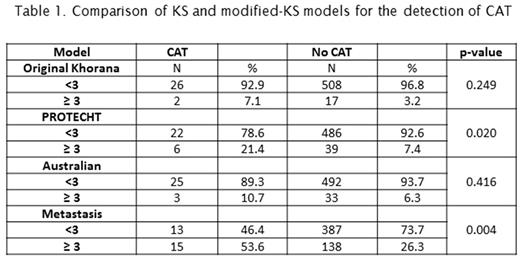Abstract
Introduction
Cancer associated venous thromboembolism (CAT) is one of the leading cause of morbidity and mortality in the cancer population. Multiple scoring systems have been developed to estimate the risk of CAT, all with variable results.
In this study, we aimed to compare the Khorana Score (KS), and three modified KS-based models in their performance to predict the occurrence of first CAT in a prospectively identified cohort of cancer patients.
Methods
We conducted a single-center cohort study of ambulatory adult cancer patients, prospectively identified at the time of routine cancer staging computed tomography scan of the chest, abdomen and/or pelvis, to evaluate the incidence of venous thromboembolism (VTE) during a period of 12 months. Patients with hematological malignancies and solid tumors were equally eligible, but those with prior history of pulmonary embolism or deep venous thrombosis and current therapeutic anticoagulation therapy were not eligible. Approval by the institutional review board and informed consent from each participant were obtained.
The charts of patients included in the study were reviewed to calculate the KS and three model modifications at the time of their study enrollment. The PROTECHT model included the use of platinum-based therapy as risk factor for VTE. The Australian model included the presence of prostate cancer, metastatic disease in breast and colorectal tumors; and adjuvant chemotherapy for colorectal cancer as additional factors for risk assessment. We also evaluated a model using the original KS with the addition of the presence of distant metastasis as additional risk factor for VTE. A value less than 3 in all the models was considered low risk for VTE while a score of 3 or higher was high risk.
We compared baseline demographics, tumor characteristics and the distribution of CAT cases between the categories of high risk for VTE and low risk of VTE for each one of the KS model groups. The distribution of each categorical variable was be summarized in terms of its frequencies and percentages. Non-parametric methods and Chi-square test or Fisher exact test was be used to assess group differences between continuous and categorical variables, respectively.
Results
Of the 553 patients included in our study, the incidence of VTE during the 12-month follow up period was 5% (28 patients). The most prevalent tumors in our study were colorectal (13.6%), lung (11.8%), renal (9.9%), breast (9.2%) and prostate (7.2%). The presence of distant metastasis at the time of study enrollment was documented in 48% of patients.
Between the four CAT prediction models, the PROTECHT model identified 21% of cases and the Metastasis model identified 54% of cases, while the original KS and the Australian model identified only 7% and 11% of cases, respectively. Those differences were statistically different (Table 1).
Conclusion
Our study suggests that the addition of platinum chemotherapy and the presence of distant metastasis in CAT prediction models might improve the detection of ambulatory cancer patients at high risk of CAT.
Escalante: Janssen: Research Funding. Rojas Hernandez: Daichii Sankyo: Research Funding.
Author notes
Asterisk with author names denotes non-ASH members.


This feature is available to Subscribers Only
Sign In or Create an Account Close Modal